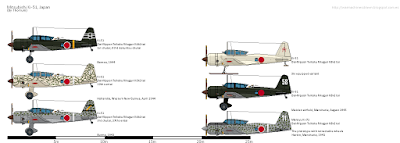The Mitsubishi Ki-51 was a light bomber which could also serve as a dive bomber that served with the Imperial Japanese Army during World War II.
It flew for the first time in mid-1939 and, initially it served in mainland China, where it proved to be too slow to hold against Allied fighters. Nonetheless, when deployed in the China-Burma-India theatre, proved to be very useful as it could operate from very improvised and rough airfields thanks to its short take-off and landing capabilities, where other aicrafts couldn't operate. As the war was turning against Japan, they were used as kamikaze aircrafts.
This aircraft was also the last Japanese aircraft that sank an American warship. On 6th August 1945 (the same day that Hiroshima was destroyed by the nuclear bomb) a Ki-51 belonging to the 73rd Independent Chutai dropped depth charges against the Balao-class submarine USS Bullhead (SS-332) in the Java sea.
It was powered by a single Mitsubishi Ha-26-II 14 cylinder air-cooled radial engine which delivered 950hp (709Kw) of power and was armed with two fixed forward-firing 7.7mm (0.303in) Type 89 machine guns, which in later models were replaced with two 12.7mm (0.5in) Ho-103 machine guns and had a defensive rearward-firing 7.7mm Te-4 machine gun in the obeserver position.
It had a payload of 200Kg (441lb) of bombs in underwing hardpoints and, for kamikaze operations it could be increased to 250Kg (551lb).
In total 2385 of them were manufactured, among them two prototypes were and eleven pre-production models. Three prototypes of the reconnaissance version were built by Mansyu with a retractable landing gear, but it didn't enter into production.
Sources:
1. https://en.wikipedia.org/wiki/Mitsubishi_Ki-51
2. https://www.militaryfactory.com/aircraft/detail.asp?aircraft_id=892
3. http://www.daveswarbirds.com/Nippon/aircraft/Sonia.htm


this is great!
ReplyDeletethanks..
best,
ruanguji